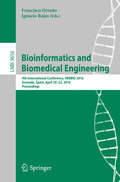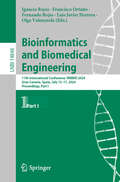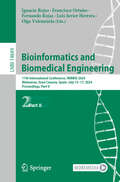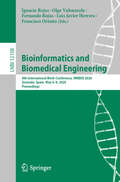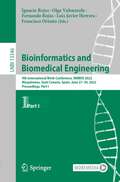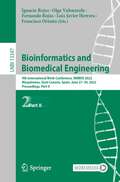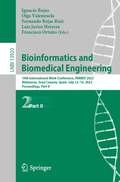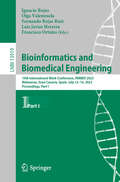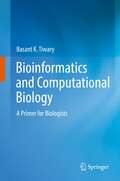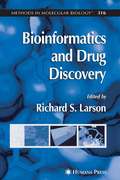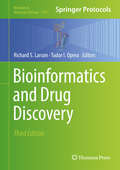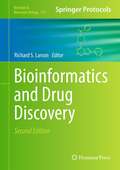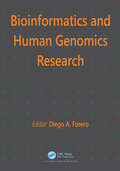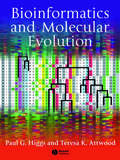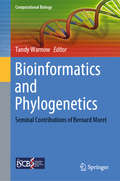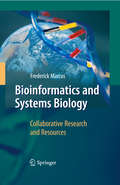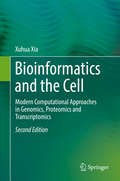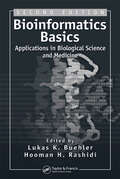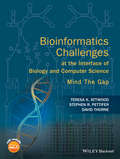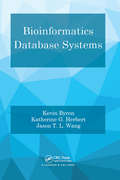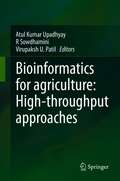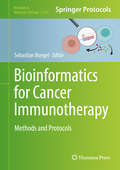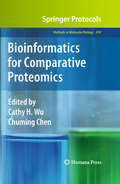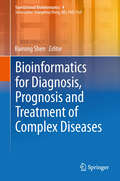- Table View
- List View
Bioinformatics and Biomedical Engineering: 4th International Conference, IWBBIO 2016, Granada, Spain, April 20-22, 2016, Proceedings (Lecture Notes in Computer Science #9656)
by Ignacio Rojas Francisco OrtuñoThis book constitutes the refereed proceedings of the 4th International Conference on Bioinformatics and Biomedical Engineering, IWBBIO 2016, held in Granada, Spain, in April 2016. The 69 papers presented were carefully reviewed and selected from 286 submissions. The scope of the conference spans the following areas: bioinformatics for healthcare and diseases; biomedical image analysis; biomedical signal analysis; computational systems for modeling biological processes; eHealth; tools for next generation sequencing data analysis; assistive technology for people with neuromotor disorders; fundamentals of biological dynamics and maximization of the information extraction from the experiments in the biological systems; high performance computing in bioinformatics, computational biology and computational chemistry; human behavior monitoring, analysis and understanding; pattern recognition and machine learning in the -omics sciences; and resources for bioinformatics.
Bioinformatics and Biomedical Engineering: 11th International Conference, IWBBIO 2024, Meloneras, Gran Canaria, Spain, July 15–17, 2024, Proceedings, Part I (Lecture Notes in Computer Science #14848)
by Ignacio Rojas Francisco Ortuño Fernando Rojas Luis Javier Herrera Olga ValenzuelaThis volume constitutes the proceedings of the 11th International Work-Conference on IWBBIO 2023, held in Gran Canaria, Spain, during July 15-17, 2022. The 54 full papers were carefully reviewed and selected from 148 submissions. They were organized in the following topical sections: Biomarker Identification, Biomedical Engineering, Biomedical Signal Analysis, E-Health.
Bioinformatics and Biomedical Engineering: 11th International Conference, IWBBIO 2024, Meloneras, Gran Canaria, Spain, July 15–17, 2024, Proceedings, Part II (Lecture Notes in Computer Science #14849)
by Ignacio Rojas Francisco Ortuño Fernando Rojas Luis Javier Herrera Olga ValenzuelaThis volume constitutes the proceedings of the 11th International Work-Conference on IWBBIO 2023, held in Meloneras, Gran Canaria, Spain, during July 15-17, 2022. The 54 full papers were carefully reviewed and selected from 148 submissions. They were organized in the following topical sections: Healthcare and Diseases, Machine Learning in Bioinformatics, New Advances in Deep Learning in Bioinformatics and Biomedicine, Novel Methodologies and Applications in Bioinformatics and Biomedicine.
Bioinformatics and Biomedical Engineering: 8th International Work-Conference, IWBBIO 2020, Granada, Spain, May 6–8, 2020, Proceedings (Lecture Notes in Computer Science #12108)
by Ignacio Rojas Olga Valenzuela Fernando Rojas Luis Javier Herrera Francisco OrtuñoThis volume constitutes the proceedings of the 8th International Work-Conference on IWBBIO 2020, held in Granada, Spain, in May 2020. The total of 73papers presented in the proceedings, was carefully reviewed and selected from 241 submissions. The papers are organized in topical sections as follows: Biomarker Identification; Biomedical Engineering; Biomedical Signal Analysis; Bio-Nanotechnology; Computational Approaches for Drug Design and Personalized Medicine; Computational Proteomics and Protein-Protein Interactions; Data Mining from UV/VIS/NIR Imaging and Spectrophotometry; E-Health Technology, Services and Applications; Evolving Towards Digital Twins in Healthcare (EDITH); High Performance in Bioinformatics; High-Throughput Genomics: Bioinformatic Tools and Medical Applications; Machine Learning in Bioinformatics; Medical Image Processing; Simulation and Visualization of Biological Systems.
Bioinformatics and Biomedical Engineering: 9th International Work-Conference, IWBBIO 2022, Maspalomas, Gran Canaria, Spain, June 27–30, 2022, Proceedings, Part I (Lecture Notes in Computer Science #13346)
by Ignacio Rojas Olga Valenzuela Fernando Rojas Luis Javier Herrera Francisco OrtuñoThis volume constitutes the proceedings of the 9th International Work-Conference on IWBBIO 2020, held in Maspalomas, Gran Canaria, Spain, in June 2022. The total of 75 papers presented in the proceedings, was carefully reviewed and selected from 212 submissions. The papers cover the latest ideas and realizations in the foundations, theory, models, and applications for interdisciplinary and multidisciplinary research encompassing disciplines of computer science, mathematics, statistics, biology, bioinformatics, and biomedicine.
Bioinformatics and Biomedical Engineering: 9th International Work-Conference, IWBBIO 2022, Maspalomas, Gran Canaria, Spain, June 27–30, 2022, Proceedings, Part II (Lecture Notes in Computer Science #13347)
by Ignacio Rojas Olga Valenzuela Fernando Rojas Luis Javier Herrera Francisco OrtuñoThis volume constitutes the proceedings of the 9th International Work-Conference on IWBBIO 2020, held in Maspalomas, Gran Canaria, Spain, in June 2022. The total of 75 papers presented in the proceedings, was carefully reviewed and selected from 212 submissions. The papers cover the latest ideas and realizations in the foundations, theory, models, and applications for interdisciplinary and multidisciplinary research encompassing disciplines of computer science, mathematics, statistics, biology, bioinformatics, and biomedicine.
Bioinformatics and Biomedical Engineering: 10th International Work-Conference, IWBBIO 2023, Meloneras, Gran Canaria, Spain, July 12–14, 2023, Proceedings, Part II (Lecture Notes in Computer Science #13920)
by Ignacio Rojas Olga Valenzuela Fernando Rojas Ruiz Luis Javier Herrera Francisco OrtuñoThis volume constitutes the proceedings of the 10th International Work-Conference on IWBBIO 2023, held in Meloneras, Gran Canaria, Spain, during July 12-14, 2022. The total of 79 papers presented in the proceedings, was carefully reviewed and selected from 209 submissions. The papers cove the latest ideas and realizations in the foundations, theory, models, and applications for interdisciplinary and multidisciplinary research encompassing disciplines of computer science, mathematics, statistics, biology, bioinformatics, and biomedicine.
Bioinformatics and Biomedical Engineering: 10th International Work-Conference, IWBBIO 2023, Meloneras, Gran Canaria, Spain, July 12–14, 2023, Proceedings, Part I (Lecture Notes in Computer Science #13919)
by Ignacio Rojas Olga Valenzuela Fernando Rojas Ruiz Luis Javier Herrera Francisco OrtuñoThis volume constitutes the proceedings of the 10th International Work-Conference on IWBBIO 2023, held in Meloneras, Gran Canaria, Spain, during July 12-14, 2022. The total of 79 papers presented in the proceedings, was carefully reviewed and selected from 209 submissions. The papers cove the latest ideas and realizations in the foundations, theory, models, and applications for interdisciplinary and multidisciplinary research encompassing disciplines of computer science, mathematics, statistics, biology, bioinformatics, and biomedicine.
Bioinformatics and Computational Biology: A Primer for Biologists
by Basant K. TiwaryThis textbook introduces fundamental concepts of bioinformatics and computational biology to the students and researchers in biology, medicine, veterinary science, agriculture, and bioengineering . The respective chapters provide detailed information on biological databases, sequence alignment, molecular evolution, next-generation sequencing, systems biology, and statistical computing using R. The book also presents a case-based discussion on clinical, veterinary, agricultural bioinformatics, and computational bioengineering for application-based learning in the respective fields. Further, it offers readers guidance on reconstructing and analysing biological networks and highlights computational methods used in systems medicine and genome-wide association mapping of diseases. Given its scope, this textbook offers an essential introductory book on bioinformatics and computational biology for undergraduate and graduate students in the life sciences, botany, zoology, physiology, biotechnology, bioinformatics, and genomic science as well as systems biology, bioengineering and the agricultural, and veterinary sciences.
Bioinformatics and Drug Discovery (Methods in Molecular Biology #316)
by Richard S. LarsonA collection of readily reproducible bioinformatic methods to advance the drug discovery process from gene identification to protein modeling to the identification of specific drug candidates. The authors demonstrate these techniques, including microarray analysis, the analysis of genes as potential drug targets, virtual screening and in silico protein design, and cheminformatics, in a variety of practical situations. Because these technologies are still emergent, each chapter contains an extended introduction that explains the theory and application of the technology and techniques described.
Bioinformatics and Drug Discovery (Methods in Molecular Biology #1939)
by Richard S. Larson Tudor I. OpreaThis third edition volume expands on the previous editions with new topics that cover drug discovery through translational bioinformatics, informatics, clinical research informatics, as well as clinical informatics. The chapters discuss new methods to study target identification, genome analysis, cheminformatics, protein analysis, and text mining. Written in the highly successful Methods in Molecular Biology series format, chapters include introductions to their respective topics, lists of the necessary materials, software workflows, reagents and on-line resources, together with step-by-step, readily reproducible laboratory and computational protocols, and tips on troubleshooting and avoiding known pitfalls.Cutting-edge and thorough, Bioinformatics and Drug Discovery, Third Edition is a valuable resource for anyone interested in drug design, including academicians (biologists, informaticists and data scientists, chemists, and biochemists), clinicians, and pharmaceutical scientists.
Bioinformatics and Drug Discovery, 2nd Edition (Methods in Molecular Biology #910)
by Richard S. LarsonRecent advances in drug discovery have been rapid. The second edition of Bioinformatics and Drug Discovery has been completely updated to include topics that range from new technologies in target identification, genomic analysis, cheminformatics, protein analysis, and network or pathway analysis. Each chapter provides an extended introduction that describes the theory and application of the technology. In the second part of each chapter, detailed procedures related to the use of these technologies and software have been incorporated. Written in the highly successful Methods in Molecular Biology™ series format, the chapters include the kind of detailed description and implementation advice that is crucial for getting optimal results in the laboratory.<P><P> Thorough and intuitive, Bioinformatics and Drug Discovery, Second Edition seeks to aid scientists in the further study of the rapidly expanding field of drug discovery
Bioinformatics and Human Genomics Research
by Diego A. ForeroAdvances in high-throughput biological methods have led to the publication of a large number of genome-wide studies in human and animal models. In this context, recent tools from bioinformatics and computational biology have been fundamental for the analysis of these genomic studies. The book Bioinformatics and Human Genomics Research provides updated and comprehensive information about multiple approaches of the application of bioinformatic tools to research in human genomics. It covers strategies analysis of genome-wide association studies, genome-wideexpression studies and genome-wide DNA methylation, among other topics. It provides interesting strategies for data mining in human genomics, network analysis, prediction of binding sites for miRNAs and transcription factors, among other themes. Experts from all around the world in bioinformatics and human genomics have contributed chapters in this book. Readers will find this book as quite useful for their in silico explorations, which would contribute to a better and deeper understanding of multiple biological processes and of pathophysiology of many human diseases.
Bioinformatics and Molecular Evolution
by Paul G. Higgs Teresa K. AttwoodIn the current era of complete genome sequencing, Bioinformatics and Molecular Evolution provides an up-to-date and comprehensive introduction to bioinformatics in the context of evolutionary biology. This accessible text: provides a thorough examination of sequence analysis, biological databases, pattern recognition, and applications to genomics, microarrays, and proteomics emphasizes the theoretical and statistical methods used in bioinformatics programs in a way that is accessible to biological science students places bioinformatics in the context of evolutionary biology, including population genetics, molecular evolution, molecular phylogenetics, and their applications features end-of-chapter problems and self-tests to help students synthesize the materials and apply their understanding is accompanied by a dedicated website - www.blackwellpublishing.com/higgs - containing downloadable sequences, links to web resources, answers to self-test questions, and all artwork in downloadable format (artwork also available to instructors on CD-ROM). This important textbook will equip readers with a thorough understanding of the quantitative methods used in the analysis of molecular evolution, and will be essential reading for advanced undergraduates, graduates, and researchers in molecular biology, genetics, genomics, computational biology, and bioinformatics courses.
Bioinformatics and Phylogenetics: Seminal Contributions of Bernard Moret (Computational Biology #29)
by Tandy WarnowThis volume presents a compelling collection of state-of-the-art work in algorithmic computational biology, honoring the legacy of Professor Bernard M.E. Moret in this field. Reflecting the wide-ranging influences of Prof. Moret’s research, the coverage encompasses such areas as phylogenetic tree and network estimation, genome rearrangements, cancer phylogeny, species trees, divide-and-conquer strategies, and integer linear programming. Each self-contained chapter provides an introduction to a cutting-edge problem of particular computational and mathematical interest.Topics and features: addresses the challenges in developing accurate and efficient software for the NP-hard maximum likelihood phylogeny estimation problem; describes the inference of species trees, covering strategies to scale phylogeny estimation methods to large datasets, and the construction of taxonomic supertrees; discusses the inference of ultrametric distances from additive distance matrices, and the inference of ancestral genomes under genome rearrangement events; reviews different techniques for inferring evolutionary histories in cancer, from the use of chromosomal rearrangements to tumor phylogenetics approaches; examines problems in phylogenetic networks, including questions relating to discrete mathematics, and issues of statistical estimation; highlights how evolution can provide a framework within which to understand comparative and functional genomics; provides an introduction to Integer Linear Programming and its use in computational biology, including its use for solving the Traveling Salesman Problem.Offering an invaluable source of insights for computer scientists, applied mathematicians, and statisticians, this illuminating volume will also prove useful for graduate courses on computational biology and bioinformatics.
Bioinformatics and RNA: A Practice-Based Approach (Innovations in Big Data and Machine Learning)
by Dolly Sharma Shailendra Singh Mamta MittalThis book offers a unique balance between a basic introductory knowledge of bioinformatics and a detailed study of algorithmic techniques. Bioinformatics and RNA: A Practice-Based Approach is a complete guide on the fundamental concepts, applications, algorithms, protocols, new trends, challenges, and research results in the area of bioinformatics and RNA.The book offers a broad introduction to the explosively growing new discipline of bioinformatics. It covers theoretical topics along with computational algorithms. It explores RNA bioinformatics, which contribute to therapeutics and drug discovery. Implementation of algorithms in a DotNet Framework with code and complete insight on the state-of-the-art and recent advancements are presented in detail. The book targets both novice readers as well as practitioners in the field. FEATURES Offers a broad introduction to the explosively growing new discipline of bioinformatics Covers theoretical topics and computational algorithms Explores RNA bioinformatics to unleash the potential from therapeutics to drug discovery Discusses implementation of algorithms in DotNet Frameworks with code Presents insights into the state of the art and recent advancements in bioinformatics The book is useful to undergraduate students with engineering, science, mathematics, or biology backgrounds. Researchers will be equally interested.
Bioinformatics and Systems Biology: Collaborative Research and Resources
by Frederick MarcusCollaborative research in bioinformatics and systems biology is a key element of modern biology and health research. This book highlights and provides access to many of the methods, environments, results and resources involved, including integral laboratory data generation and experimentation and clinical activities. Collaborative projects embody a research paradigm that connects many of the top scientists, institutions, their resources and research worldwide, resulting in first-class contributions to bioinformatics and systems biology. Central themes include describing processes and results in collaborative research projects using computational biology and providing a guide for researchers to access them. The book is also a practical guide on how science is managed. It shows how collaborative researchers are putting results together in a way accessible to the entire biomedical community.
Bioinformatics and the Cell: Modern Computational Approaches in Genomics, Proteomics and Transcriptomics
by Xuhua XiaThis second edition integrates the more technical and mathematical aspects of bioinformatics with concrete examples of their application to current research problems in molecular, cellular and evolutionary biology. This broad, unified approach is made possible, in large part, by the very wide scope of Dr. Xia’s own research experience. The integration of genomics, proteomics and transcriptomics into a single volume makes this book required reading for anyone entering the new and emerging fields of Systems Biology and Evolutionary Bioinformatics.
Bioinformatics Basics: Applications in Biological Science and Medicine
by Lukas K. Buehler Hooman H. RashidiEvery researcher in genomics and proteomics now has access to public domain databases containing literally billions of data entries. However, without the right analytical tools, and an understanding of the biological significance of the data, cataloging and interpreting the molecular evolutionary processes buried in those databases is difficult, if
Bioinformatics Challenges at the Interface of Biology and Computer Science: Mind the Gap
by Stephen R. Pettifer Teresa K. Attwood David ThorneThis innovative book provides a completely fresh exploration of bioinformatics, investigating its complex interrelationship with biology and computer science. It approaches bioinformatics from a unique perspective, highlighting interdisciplinary gaps that often trap the unwary. The book considers how the need for biological databases drove the evolution of bioinformatics; it reviews bioinformatics basics (including database formats, data-types and current analysis methods), and examines key topics in computer science (including data-structures, identifiers and algorithms), reflecting on their use and abuse in bioinformatics. Bringing these disciplines together, this book is an essential read for those who wish to better understand the challenges for bioinformatics at the interface of biology and computer science, and how to bridge the gaps. It will be an invaluable resource for advanced undergraduate and postgraduate students, and for lecturers, researchers and professionals with an interest in this fascinating, fast-moving discipline and the knotty problems that surround it.
Bioinformatics Database Systems
by Kevin Byron Katherine G. Herbert Jason T. WangModern biological databases comprise not only data, but also sophisticated query facilities and bioinformatics data analysis tools. This book provides an exploration through the world of Bioinformatics Database Systems. The book summarizes the popular and innovative bioinformatics repositories currently available, including popular primary genetic and protein sequence databases, phylogenetic databases, structure and pathway databases, microarray databases and boutique databases. It also explores the data quality and information integration issues currently involved with managing bioinformatics databases, including data quality issues that have been observed, and efforts in the data cleaning field. Biological data integration issues are also covered in-depth, and the book demonstrates how data integration can create new repositories to address the needs of the biological communities. It also presents typical data integration architectures employed in current bioinformatics databases. The latter part of the book covers biological data mining and biological data processing approaches using cloud-based technologies. General data mining approaches are discussed, as well as specific data mining methodologies that have been successfully deployed in biological data mining applications. Two biological data mining case studies are also included to illustrate how data, query, and analysis methods are integrated into user-friendly systems. Aimed at researchers and developers of bioinformatics database systems, the book is also useful as a supplementary textbook for a one-semester upper-level undergraduate course, or an introductory graduate bioinformatics course.
Bioinformatics for agriculture: High-throughput approaches
by Atul Kumar Upadhyay R Sowdhamini Virupaksh U. PatilThis book illustrates the importance and significance of bioinformatics in the field of agriculture. It first introduces the basic concepts of bioinformatics, such as homologous sequence and gene function analyses, determination of protein structures, and discusses machine learning applications for an in-depth understanding of the desired genes and proteins based on commonly used bioinformatics software and tools, e.g. BLAST, molecular modelling, molecular-docking and simulations, protein-protein and domain-domain interactions. The book also describes recent advances in the high-throughput analysis of whole genome and transcriptome using next-generation sequencing platforms, and functional proteome studies. It also examines the role of computational biology in understanding and improving the nutrient quality and yield of crops. Lastly, the book explores a comprehensive list of applications of bioinformatics to improve plant yield, biomass, and health, and the challenges involved.
Bioinformatics for Cancer Immunotherapy: Methods and Protocols (Methods in Molecular Biology #2120)
by Sebastian BoegelThis volume focuses on a variety of in silico protocols of the latest bioinformatics tools and computational pipelines developed for neo-antigen identification and immune cell analysis from high-throughput sequencing data for cancer immunotherapy. The chapters in this book cover topics that discuss the two emerging concepts in recognition of tumor cells using endogenous T cells: cancer vaccines against neo-antigens presented on HLA class I and II alleles, and checkpoint inhibitors. Written in the highly successful Methods in Molecular Biology series format, chapters include introductions to their respective topics, lists of the necessary materials and reagents, step-by-step, readily reproducible laboratory protocols, and tips on troubleshooting and avoiding known pitfalls.Cutting-edge and authoritative, Bioinformatics for Cancer Immunotherapy: Methods and Protocols is a valuable research tool for any scientist and researcher interested in learning more about this exciting and developing field.
Bioinformatics for Comparative Proteomics (Methods in Molecular Biology #694)
by Cathy H. Wu Chuming ChenWith the rapid development of proteomic technologies in the life sciences and in clinical applications, many bioinformatics methodologies, databases, and software tools have been developed to support comparative proteomics study. In Bioinformatics for Comparative Proteomics, experts in the field highlight the current status, challenges, open problems, and future trends for developing bioinformatics tools and resources for comparative proteomics research in order to deliver a definitive reference providing both the breadth and depth needed on the subject. Structured in three major sections, this detailed volume covers basic bioinformatics frameworks relating to comparative proteomics, bioinformatics databases and tools for proteomics data analysis, and integrated bioinformatics systems and approaches for studying comparative proteomics in the systems biology context. Written for the highly successful Methods in Molecular BiologyTM series, the contributions in this book provide the meticulous, step-by-step description and implementation advice that is crucial for getting optimal results in the lab. Comprehensive and easy-to-use, Bioinformatics for Comparative Proteomics serves all readers who wish to learn about state-of-the-art bioinformatics databases and tools, novel computational methods and future trends in proteomics data analysis, and comparative proteomics in systems biology.
Bioinformatics for Diagnosis, Prognosis and Treatment of Complex Diseases (Translational Bioinformatics #4)
by Bairong ShenThe book introduces the bioinformatics tools, databases and strategies for the translational research, focuses on the biomarker discovery based on integrative data analysis and systems biological network reconstruction. With the coming of personal genomics era, the biomedical data will be accumulated fast and then it will become reality for the personalized and accurate diagnosis, prognosis and treatment of complex diseases. The book covers both state of the art of bioinformatics methodologies and the examples for the identification of simple or network biomarkers. In addition, bioinformatics software tools and scripts are provided to the practical application in the study of complex diseases. The present state, the future challenges and perspectives were discussed. The book is written for biologists, biomedical informatics scientists and clinicians, etc. Dr. Bairong Shen is Professor and Director of Center for Systems Biology, Soochow University; he is also Director of Taicang Center for Translational Bioinformatics.
